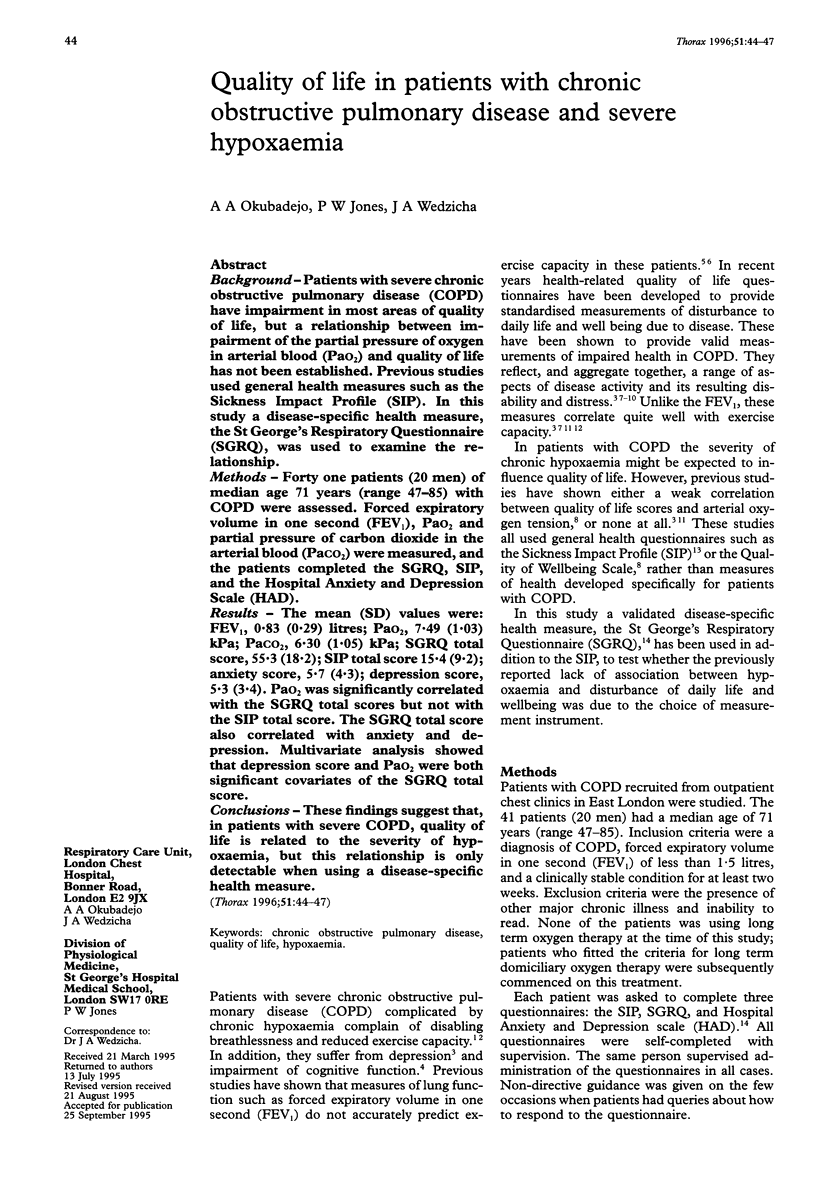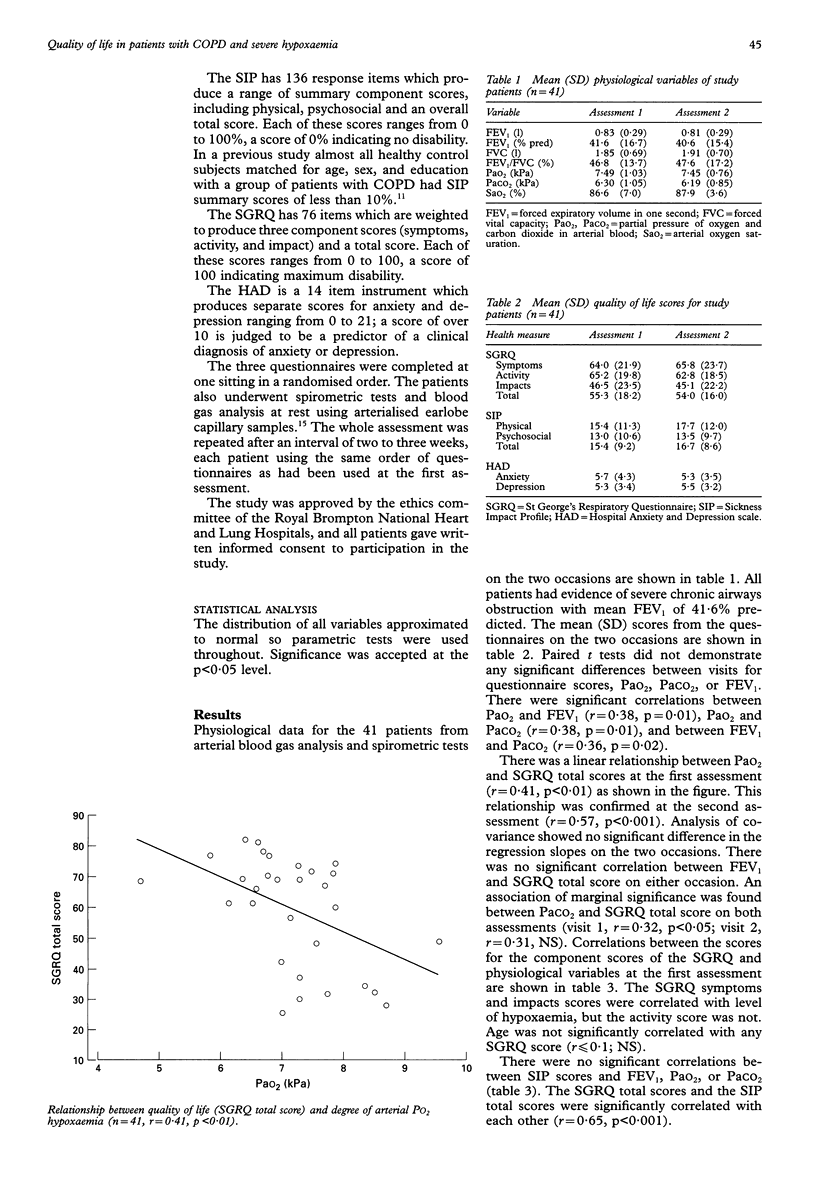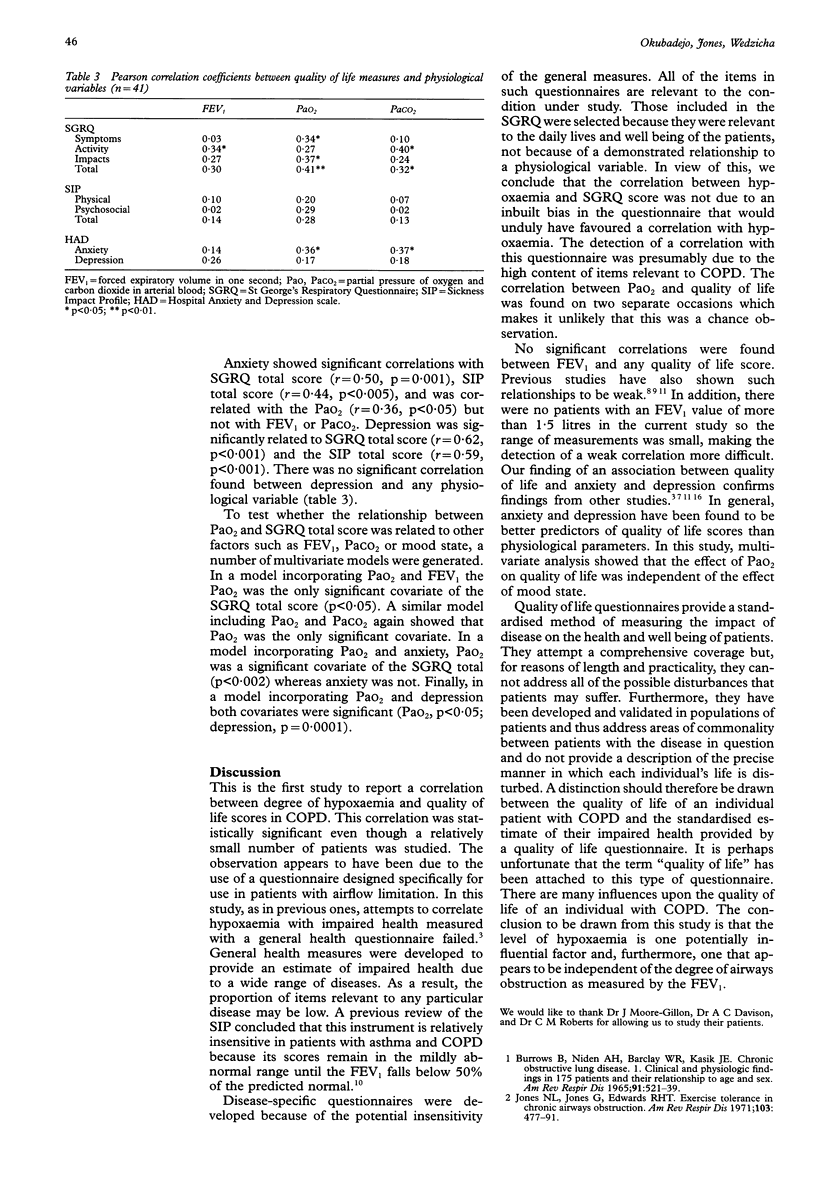Abstract
BACKGROUND: Patients with severe chronic obstructive pulmonary disease (COPD) have impairment in most areas of quality of life, but a relationship between impairment of the partial pressure of oxygen in arterial blood (PaO2) and quality of life has not been established. Previous studies used general health measures such as the Sickness Impact Profile (SIP). In this study a disease-specific health measure, the St George's Respiratory Questionnaire (SGRQ), was used to examine the relationship. METHODS: Forty one patients (20 men) of median age 71 years (range 47-85) with COPD were assessed. Forced expiratory volume in one second (FEV1), PaO2 and partial pressure of carbon dioxide in the arterial blood (PaCO2) were measured, and the patients completed the SGRQ, SIP, and the Hospital Anxiety and Depression Scale (HAD). RESULTS: The mean (SD) values were: FEV1, 0.83 (0.29) litres; PaO2, 7.49 (1.03) kPa; PaCO2, 6.30 (1.05) kPa; SGRQ total score, 55.3 (18.2); SIP total score 15.4 (9.2); anxiety score, 5.7 (4.3); depression score, 5.3 (3.4). PaO2 was significantly correlated with the SGRQ total scores but not with the SIP total score. The SGRQ total score also correlated with anxiety and depression. Multivariate analysis showed that depression score and PaO2 were both significant covariates of the SGRQ total score. CONCLUSIONS: These findings suggest that, in patients with severe COPD, quality of life is related to the severity of hypoxaemia, but this relationship is only detectable when using a disease-specific health measure.
Full text
PDF



Selected References
These references are in PubMed. This may not be the complete list of references from this article.
- BURROWS B., NIDEN A. H., BARCLAY W. R., KASIK J. E. CHRONIC OBSTRUCTIVE LUNG DISEASE. I. CLINICAL AND PHYSIOLOGIC FINDINGS IN 175 PATIENTS AND THEIR RELATIONSHIP TO AGE AND SEX. Am Rev Respir Dis. 1965 Apr;91:521–540. doi: 10.1164/arrd.1965.91.4.521. [DOI] [PubMed] [Google Scholar]
- Bergner M., Bobbitt R. A., Carter W. B., Gilson B. S. The Sickness Impact Profile: development and final revision of a health status measure. Med Care. 1981 Aug;19(8):787–805. doi: 10.1097/00005650-198108000-00001. [DOI] [PubMed] [Google Scholar]
- Grant I., Heaton R. K., McSweeny A. J., Adams K. M., Timms R. M. Neuropsychologic findings in hypoxemic chronic obstructive pulmonary disease. Arch Intern Med. 1982 Aug;142(8):1470–1476. [PubMed] [Google Scholar]
- Guyatt G. H., Berman L. B., Townsend M., Pugsley S. O., Chambers L. W. A measure of quality of life for clinical trials in chronic lung disease. Thorax. 1987 Oct;42(10):773–778. doi: 10.1136/thx.42.10.773. [DOI] [PMC free article] [PubMed] [Google Scholar]
- Jones N. L., Jones G., Edwards R. H. Exercise tolerance in chronic airway obstruction. Am Rev Respir Dis. 1971 Apr;103(4):477–491. doi: 10.1164/arrd.1971.103.4.477. [DOI] [PubMed] [Google Scholar]
- Jones P. W., Baveystock C. M., Littlejohns P. Relationships between general health measured with the sickness impact profile and respiratory symptoms, physiological measures, and mood in patients with chronic airflow limitation. Am Rev Respir Dis. 1989 Dec;140(6):1538–1543. doi: 10.1164/ajrccm/140.6.1538. [DOI] [PubMed] [Google Scholar]
- Jones P. W. Quality of life measurement for patients with diseases of the airways. Thorax. 1991 Sep;46(9):676–682. doi: 10.1136/thx.46.9.676. [DOI] [PMC free article] [PubMed] [Google Scholar]
- Jones P. W., Quirk F. H., Baveystock C. M., Littlejohns P. A self-complete measure of health status for chronic airflow limitation. The St. George's Respiratory Questionnaire. Am Rev Respir Dis. 1992 Jun;145(6):1321–1327. doi: 10.1164/ajrccm/145.6.1321. [DOI] [PubMed] [Google Scholar]
- Kaplan R. M., Atkins C. J., Timms R. Validity of a quality of well-being scale as an outcome measure in chronic obstructive pulmonary disease. J Chronic Dis. 1984;37(2):85–95. doi: 10.1016/0021-9681(84)90050-x. [DOI] [PubMed] [Google Scholar]
- Killian K. J., Leblanc P., Martin D. H., Summers E., Jones N. L., Campbell E. J. Exercise capacity and ventilatory, circulatory, and symptom limitation in patients with chronic airflow limitation. Am Rev Respir Dis. 1992 Oct;146(4):935–940. doi: 10.1164/ajrccm/146.4.935. [DOI] [PubMed] [Google Scholar]
- McGavin C. R., Gupta S. P., McHardy G. J. Twelve-minute walking test for assessing disability in chronic bronchitis. Br Med J. 1976 Apr 3;1(6013):822–823. doi: 10.1136/bmj.1.6013.822. [DOI] [PMC free article] [PubMed] [Google Scholar]
- McSweeny A. J., Grant I., Heaton R. K., Adams K. M., Timms R. M. Life quality of patients with chronic obstructive pulmonary disease. Arch Intern Med. 1982 Mar;142(3):473–478. [PubMed] [Google Scholar]
- Morgan A. D., Peck D. F., Buchanan D. R., McHardy G. J. Effect of attitudes and beliefs on exercise tolerance in chronic bronchitis. Br Med J (Clin Res Ed) 1983 Jan 15;286(6360):171–173. doi: 10.1136/bmj.286.6360.171. [DOI] [PMC free article] [PubMed] [Google Scholar]
- Pitkin A. D., Roberts C. M., Wedzicha J. A. Arterialised earlobe blood gas analysis: an underused technique. Thorax. 1994 Apr;49(4):364–366. doi: 10.1136/thx.49.4.364. [DOI] [PMC free article] [PubMed] [Google Scholar]
- Prigatano G. P., Wright E. C., Levin D. Quality of life and its predictors in patients with mild hypoxemia and chronic obstructive pulmonary disease. Arch Intern Med. 1984 Aug;144(8):1613–1619. [PubMed] [Google Scholar]
- Zigmond A. S., Snaith R. P. The hospital anxiety and depression scale. Acta Psychiatr Scand. 1983 Jun;67(6):361–370. doi: 10.1111/j.1600-0447.1983.tb09716.x. [DOI] [PubMed] [Google Scholar]


